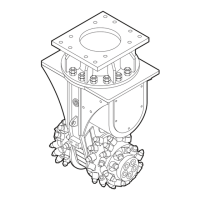◆
Secure the carrier such that it cannot move
unexpectedly.
◆
Change the oil filter cartridge after the first 50
operating hours.
◆
Check the oil filter every 500 operating hours
and replace if it is necessary.
Replace hydraulic hoses
◆
Replace the hydraulic hoses:
•
if they are more than six years old.
•
if the outer layer is damaged.
•
if they become brittle or deformed.
•
if the hose fitting is deformed or damaged.
•
if they loosen from the fittings.
WARNING Risk of injury due to high
pressure in the hydraulic circuit
High pressures are present in the hydraulic circuit,
which can cause bursts in the event of a failure to
observe the specifications, and thus lead to
serious injuries.
►
Prior to all work, depressurise hydraulic devices
and lines and safeguard against a restart (see
chapter Depressurising the hydraulic system).
►
Do not tighten screw connections which are
under pressure.
►
Always use the requisite personal protective
gear.
►
Always use hydraulic lines which are intended
for the respective purpose.
►
Always install hydraulic lines correctly and
protect these against mechanical and thermal
damage.
►
Do not exceed the nominal pressure for the
hydraulic lines.
WARNING Risk of accidents due to use of
old parts
Using old parts (old hydraulic hoses, screws or
clips) can lead to accidents, which may in turn
result in severe injuries.
►
Only use new parts.
►
Only use original parts.
Note: When working on the hydraulic circuit,
always have suitable oil receiver tanks available
and collect oil for environmental reasons.
Note: When changing the hydraulic hoses, always
use the manufacturer's original parts exclusively.
◆
Clean the immediate environment around the
hydraulic hose connections requiring
replacement.
◆
Loosen the threaded connections on the
hydraulic hose fittings.
◆
Loosen the hose fittings on the carrier.
◆
Remove the hydraulic hose and insert end caps
into all fitting openings.
◆
Unscrew the end cap from one side of the new
hydraulic hose.
◆
Place a new hydraulic hose on the fitting.
◆
Tighten the new hydraulic hose (see chapter
Bolt connections/Tightening torques).
Actions following
maintenance
After completing the maintenance work and prior to
switching on the hydraulic attachment carry out the
following steps:
◆
Check that all previously loosened threaded
connections have been tightened.
◆
Check that all previously removed safety
devices and covers have been replaced in an
orderly manner.
◆
Ensure that all tools, materials and other
equipment used have been removed from the
working area.
◆
Clean the working area and remove spilled
substances such as liquids, processing
materials and similar.
◆
Ensure that all safety devices on the hydraulic
attachment are fully functional.
◆
Ensure that the stipulated prerequisites for the
carrier have been fulfilled (see chapter
Preconditions for the carrier).
Safety and operating instructions DC 200, 400, 600, 1000, 1200, 2000, 2100, 2900
54 © Construction Tools GmbH | 3390 5192 01 | 2016-12-01
Original instructions

